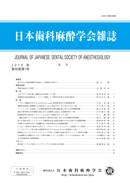50 巻, 2 号
選択された号の論文の14件中1~14を表示しています
- |<
- <
- 1
- >
- >|
総説
-
2022 年 50 巻 2 号 p. 43-51
発行日: 2022/04/15
公開日: 2022/04/15
PDF形式でダウンロード (571K)
原著
-
2022 年 50 巻 2 号 p. 52-65
発行日: 2022/04/15
公開日: 2022/04/15
PDF形式でダウンロード (4749K)
臨床
-
2022 年 50 巻 2 号 p. 66-69
発行日: 2022/04/15
公開日: 2022/04/15
PDF形式でダウンロード (1524K)
短報
-
2022 年 50 巻 2 号 p. 70-72
発行日: 2022/04/15
公開日: 2022/04/15
PDF形式でダウンロード (314K) -
2022 年 50 巻 2 号 p. 73-75
発行日: 2022/04/15
公開日: 2022/04/15
PDF形式でダウンロード (238K) -
2022 年 50 巻 2 号 p. 76-78
発行日: 2022/04/15
公開日: 2022/04/15
PDF形式でダウンロード (301K) -
2022 年 50 巻 2 号 p. 79-81
発行日: 2022/04/15
公開日: 2022/04/15
PDF形式でダウンロード (256K) -
2022 年 50 巻 2 号 p. 82-84
発行日: 2022/04/15
公開日: 2022/04/15
PDF形式でダウンロード (576K) -
2022 年 50 巻 2 号 p. 85-87
発行日: 2022/04/15
公開日: 2022/04/15
PDF形式でダウンロード (277K) -
2022 年 50 巻 2 号 p. 88-90
発行日: 2022/04/15
公開日: 2022/04/15
PDF形式でダウンロード (405K) -
2022 年 50 巻 2 号 p. 91-93
発行日: 2022/04/15
公開日: 2022/04/15
PDF形式でダウンロード (209K)
学術集会講演論文
-
2022 年 50 巻 2 号 p. 94-99
発行日: 2022/04/15
公開日: 2022/04/15
PDF形式でダウンロード (643K) -
2022 年 50 巻 2 号 p. 100-105
発行日: 2022/04/15
公開日: 2022/04/15
PDF形式でダウンロード (9057K)
リフレッシャーコース講演論文
-
2022 年 50 巻 2 号 p. 106-109
発行日: 2022/04/15
公開日: 2022/04/15
PDF形式でダウンロード (539K)
- |<
- <
- 1
- >
- >|
